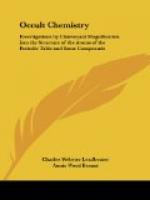II and IIa. The Tetrahedron.—The characteristics of this form are four funnels, containing ovoid bodies, opening on the face of a tetrahedron. The funnels generally, but not always, radiate from a central globe. We give beryllium (glucinum) as the simplest example (2 on Plate III), and to this group belong calcium and strontium. The tetrahedron is the form of chromium and molybdenum, but not that of the head of their group, oxygen, which is, like hydrogen, sui generis. These two groups are marked in orthodox chemistry as respectively positive and negative, and are closely allied. Another pair of groups show the same tetrahedral form: magnesium, zinc and cadmium, positive; sulphur, selenium and tellurium, negative. Selenium is a peculiarly beautiful element, with a star floating across the mouth of each funnel; this star is extremely sensitive to light, and its rays tremble violently and bend if a beam of light falls on it. All these are dyads.
The tetrahedron is not confined to the external form of the above atoms; it seems to be one of the favourite forms of nature, and repeatedly appears in the internal arrangements. There is one tetrahedron within the unknown element occultum; two appear in helium (3 on Plate III); yttrium has also two within its cube, as has germanium; five, intersecting, are found in neon, meta-neon, argon, metargon, krypton, meta-krypton, xenon, meta-xenon, kalon, meta-kalon, tin, titanium and zirconium. Gold contains no less than twenty tetrahedra.
III. The Cube.—The cube appears to be the form of triads. It has six funnels, containing ovoids, and opening on the faces of the cube. Boron is chosen as an example (4 on Plate III). Its group members, scandium and yttrium, have the same form; we have not examined the fourth; the group is positive. Its negative complement consists of nitrogen, vanadium and niobium, and we have again to note that nitrogen, like hydrogen and oxygen, departs from its group type. Two other triad groups, the positive aluminium, gallium and indium (the fourth unexamined) and the negative phosphorus, arsenic and antimony (the fourth unexamined), have also six funnels opening on the faces of a cube.
IV. The Octahedron.—The simplest example of this is carbon (5 on Plate III). We have again the funnel with its ovoids, but now there are eight funnels opening on the eight faces of the octahedron. In titanium (6 on Plate III) the form is masked by the protruding arms, which give the appearance of the old Rosicrucian Cross and Rose, but when we look into the details later, the carbon type comes out clearly. Zirconium is exactly like titanium in form, but contains a large number of atoms. We did not examine the remaining two members of this group. The group is tetratomic and positive. Its negative pendant shows the same form in silicon, germanium and tin; again, the fourth was unexamined.
[Illustration: PLATE IV.]




